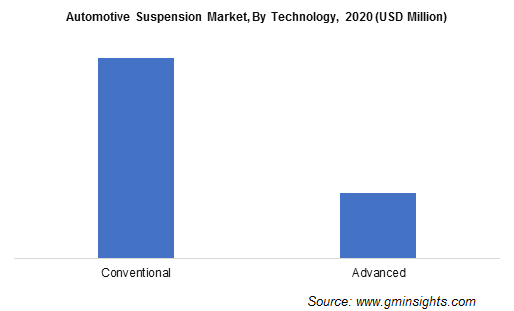Automotive Suspension Market worth over $695 Bn by 2026
Published Date: May 2020
Automotive Suspension Market size is set to exceed USD 695 billion by 2026, according to a new research report by Global Market Insights Inc.
Automotive suspension offers cushioning effect to the vehicle during operation on uneven surface. It ensures that vehicle stays in contact with ground and provides comfort in the cabin. The automotive suspension system works on the principle of force dissipation that includes conversion of force into heat thereby protecting the vehicle from impact. It enhances the road holding ability during cornering, driving & braking and safeguards the occupants from road shocks.
Increasing popularity of lightweight vehicles will influence the market demand for automotive suspensions
Government authorities are formulating regulatory guidelines to reduce the vehicle weights that will help in improving the fuel efficiency. Additionally, it will assist in reducing the CO2 emission levels. The vehicle manufacturers are incorporating technological advents in automotive suspension systems to minimize the weight of suspension systems.

Get more details on this report - Request Free Sample PDF
Conventional segment will witness around 7.5% CAGR in the automotive suspension market through 2026. The OEMs employ vehicles with passive system to control vertical motion, pitch, and roll. In this suspension, the elements do not offer energy to system. It restricts the motion of the body and wheel by limiting the relative velocities to a rate that provides required ride comfort. Further, it is less flexible and transfer a lot of road input on the vehicle body.
Double wishbone four-wheeler suspension segment will reach a valuation of around USD 95 billion by 2026 owing to superior flexibility. This suspension system includes vertical upper and lower arms, also known as control arms or double A-arms which are located between car chassis and wheel assembly. The control arms are incorporated with ball joints on both ends allowing movement in various directions. This automotive suspension offers flexibility to control parameters such as caster, camber, toe, etc. However, it is more complex and requires additional parts that results into extra weight. The repair, modification and maintenance costs associated with double wishbone suspension are high.
Browse key industry insights spread across 245 pages with 355 market data tables & 23 figures & charts from the report, “Automotive Suspension Market Size By Architecture (Four-wheeler Suspension [MacPherson Strut, Double Wishbone, Rigid Axle, Multi-link, Twist-beam], Two-wheeler Suspension), By Type (Four-wheeler Suspension [Dependent, Independent, Semi-independent], Two-wheeler Suspension [Front Telescopic Suspension, Rear Dual Shock Suspension, Rear Monoshock Suspension]), By Technology (Conventional, Advanced), By Distribution Channel (OEM, Aftermarket), By Vehicle Type (Passenger Cars, Light Commercial Vehicles, Heavy Commercial Vehicles, Two-wheelers), Industry Analysis Report, Regional Outlook, Growth Potential, Price Trends, Competitive Market Share & Forecast, 2020 - 2026” in detail along with the table of contents: https://www.gminsights.com/industry-analysis/automotive-suspension-market
Heavy commercial vehicles to support dependent suspension penetration
Dependent suspension will register substantial gains during the forecast timeframe with increasing commercial vehicle fleet. Proliferating e-commerce and logistics industry across the globe are escalating the demand for commercial vehicles. In the dependent suspension, the motion on one wheel induced by road irregularities affect the other wheel as well. It has a rigid mechanical linkage between the two wheels of same axle that makes it is more suitable for commercial vehicles to handle heavy loads.
Aftermarket segment will foresee significant growth in the coming years due to increasing vehicle population leading to surge in collisions. Changing consumer dynamics and low cost of aftermarket components will induce significant growth potential in the industry landscape. Additionally, online e-retailing will generate more opportunities for the growth of aftermarket segment as it offers convenience, freedom of choice and round-the-clock service in comparison with offline stores.
Product differentiation & development will form the basis of business expansion
Some of the key automotive suspension manufacturers are Ohlins, Continental AG, KYB Corporation, ZF, Tenneco, Mando Corporation, Showa Corporation and Endurance Technologies. In February 2019, KYB Corporation launched its tenth edition of passenger & light commercial shock absorber catalogue. Such initiatives will help the company to strengthen its market position and gain advantage over its competitors.





